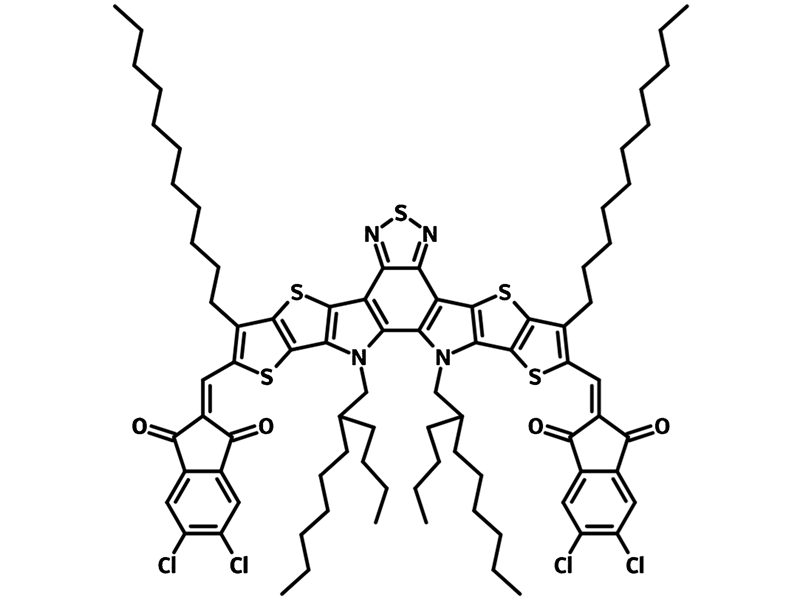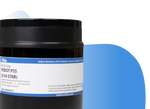ZY-4Cl, non-fullerene acceptor and Y6 family member
With an increased LUMO energy level, giving higher open voltage
Specifications | Pricing and Options | MSDS | Literature and Reviews
ZY-4Cl (CAS number 2703920-28-7), a modified version of BTP-4Cl-12, belongs to the Y6 non-fullerene acceptors family with a fused thienothienopyrrolo-thienothienoindole (TTP-TTI) core and 5,6-dichloro-1H-indene-1,3(2H)-dione peripheral end groups.
The replacement of the cyano groups with carbonyl groups significantly increases the LUMO energy level of ZY-4Cl due to the reduced electron-withdrawing effect of the carbonyl groups, giving higher open voltage (VOC) however sacrificing its light absorption capability in the NIR region. The modification of the structure also reduces the miscibility between the polymer donor, i.e. P3HT and ZY-4Cl, which improves the phase separation morphology of the P3HT:ZY-4Cl-based active layer for efficient charge transport with reduced charge recombination.
ZY-4Cl can also be added as the third component in organic solar cells not only to improve the device performing efficiency but also to enhance the stability of the device. PM6:Y6-based OPV with ZY-4Cl as the additive exhibited good air stability, maintaining 94% of its initial PCE for over 1390 h (25 °C, 40% humidity).
PCE of 9.46% has been achieved for P3HT based polymer organic solar cells when ZY-4Cl was used as the non-fullerene acceptor. Further device performance improvement to PCE over 10% was observed when a volatilizable solid additive SA4 (2-(thiophen-2-ylmethylene)-1H-indene-1,3(2H)-dione) was introduced in the active layer.
High efficient non-fullerene acceptor
with highly conjugated core
Reduces charge recombination
By improving phase separation of the donor and acceptor
Worldwide shipping
Quick and reliable shipping
High purity
>98% High purity
Device structure: ITO/PEDOT:PSS/P3HT:ZY-4Cl//Al
| Thickness (nm) | VOC (V) | JSC (mA cm-2) | FF (%) | PCE (%) |
|---|---|---|---|---|
| 100 | 0.88 | 16.49 | 65 | 9.46 |
Chemical Structure

General Information
| CAS Number | 2703920-28-7 |
|---|---|
| Chemical Formula | C84H102Cl4N4O4S5 |
| Purity | >98% (1HNMR) |
| Full Name | 2,2’-((2Z,2'Z)-((12,13-bis(2-butyloctyl)-3,9-diundecyl-12,13-dihydro-[1,2,5]-thiadiazolo[3,4-e]thieno[2′′,3′′:4′,5′]thieno[2′,3′:4,5]pyrrolo[3,2-g]thieno[2′,3′:4,5]thieno[3,2-b]indole-2,10-diyl)bis(methane-lylidene)))bis(5,6-dichloro-1H-indene-1,3(2H)-dione) |
| Molecular Weight | 1533.87 g/mol |
| HOMO / LUMO | HOMO = -5.64 eV, LUMO = -3.67 eV [1] |
| Solubility | Chloroform, chlorobenzene |
| Form | Dark blue to black powder/crystals |
| Synonyms | BTP-IO-4Cl |
| Classification / Family | NFAs, n-type non-fullerene electron acceptors, organic semiconducting materials, low band-gap small molecule, small molecular acceptor, organic photovoltaics, organic photodetectors (OPDs), polymer solar cells, NF-PSCs |
Pricing
| Batch | Quantity | Price |
|---|---|---|
| M2350A1 | 50 mg | £260 |
| M2350A1 | 100 mg | £370 |
| M2350A1 | 250 mg | £750 |
MSDS Documentation
Literature and Reviews
- Molecular design of a non-fullerene acceptor enables a P3HT-based organic solar cell with 9.46% efficiency, Energy Environ. Sci., 13, 2864--2869 (2020); DOI: 10.1039/d0ee01763a.
- Thermally stable poly(3-hexylthiophene): Nonfullerene solar cells with efficiency breaking 10%, M. Gao et al., Aggreg., e190 (2022); DOI: 10.1002/agt2.190.
- Achieving over 10% Efficiency in Poly(3-hexylthiophene)-Based Organic Solar Cells via Solid Additives, C. Yang et al., ChemSusChem 14 (17), 3607-3613 (2021); DOI: 10.1002/cssc.202100627.
Related Products
Semiconducting polymers for bulk heterojunction, OPV, OLED, OFET and perovskite interfaces and solar cell research.


